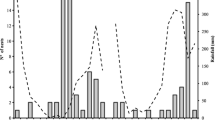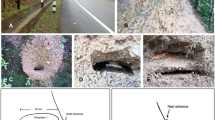Summary
Nest relocation behavior in the Japanese queenless ant,Pristomyrmex pungens (Myrmicinae), was investigated in two study fields (site A and site Y) in Nagoya City. This species did not construct elaborate subterranean nests but frequently relocated its nests instead. Mean nest longevities were 17.4 days in site A and 15.7 days in site Y, shorter than those of other ants living in similar climatic regions. There was no apparent seasonal change in the frequency of nest relocation throughout the ant's active season, but nest site preference changed seasonally. Nest relocations did not follow a cyclical pattern. Despite the frequent nest relocations, nests were always distributed uniformly. Mean nest relocation distances were 6.8 m in site A and 3.9 m in site Y. Two consecutive nest relocations tended to be in opposite directions. The direction of nest movement was not affected by the distance to a neighbouring nest. Nest movements were usually confined within a small area. Time spent by a colony to relocate its nest was estimated as 20 hr. The proportion of polydomous colonies was 13.7e% in site A and 2.3% in site Y (facultative polydomy). Number of nests per colony tended to increase in summer. Artificial removal of weeds on which workers were collecting aphids' elicited nest relocation. Adaptive and ecological significances of the nest relocation of this ant were discussed.
Zusammenfassung
Das Nestplatzwechselverhalten der königinnenlosen japanischen AmeisePristomyrmex pungens (Myrmicinae) wurde an zwei Stellen (A und Y) im Stadtgebiet von Nagoya untersucht. Diese Art legt keine wohlausgebauten unterirdischen Nester an, sondern wechselt statt dessen häufig ihren Nistplatz.
Die mittlers Aufenhaltsdauer an einem Nestplatz, betrug 17,4 Tage an Stelle A und 17.7 Tage an Stelle Y. Dies ist kürzer als bei anderen Ameisen, die in klimatisch ähnlichen Gebieten leben. Es gab keine erkennbaren jahreszeitlichen Anderungen in der Häufigkeit des Umziehens während der Aktivitätsphase der Ameisen, jedoch schwankeb die Nestplatzpräferenzen saisonal. Der Nestwechsel folgt keinem zyklischen Rhythmus.
Trotz der häufigen Nestwechsel waren die Nester stets gleichmäßig verteilt. Die mittlers Umzugsdistanzen betrugen an Platz A 6,8 m und an Platz Y 3,9 m. Zwei aufei nanderfolgende Umzüge tendierten dazu, in entgegengesetzte Richtungen zu führen. Die Umzugsrichtung wurde nicht durch die Distanz zu einem Nachbarnest beeinflußt. Umzüge fanden in der Regel kleinräumig statt.
Die Zeit, die eine Kolonie für den Umzug benötigte, wurde auf 20 Stunden geschätzt. Der Anteil an polydomen Kolonien betrug an Stelle A 13,7 und an Stelle Y 2,3% (fakultative Polydomie). Der Anteil der Zweignester pro Kolonie zeigt im Sommer eine zunehmende Tendenz. Künstliche Entfernung von Pflanzen, auf denen die Ameisen Honigtau von Blattläusen sammleten, löste Nestwechsel aus. Es wird diskutiert, welche adaptive und ökologische Bedeutung der Nestwechsel bei dieser Ameise besitzt.
Similar content being viewed by others
References
Batschelet E, 1981.—Circular Statistics in Biology. Academic Press, London.
Bradley G.A., 1972.—TransplantingFormica obscuripes andDolichoderus taschenbergi (Hymenoptera: Formicidae) colonies in jack pine stands of Southeastern Manitoba.Canadian Entomol., 104, 245–249.
Bradley G.A., 1973.—Interference between nest population ofFormica obscuripes andDolichoderus taschenbergi (Hymenoptera: Formicidae).Canadian Entomol., 105, 1525–1528.
Brian M.V., 1952.—The structure of a dense natural ant population.J. Anim. Ecol., 21, 12–24.
Brian M.V., 1956.—Segregation of species of the ant genusMyrmica.J. Anim. Ecol., 25, 319–337.
Brian M.V., Hibble J. Kelly A.F., 1966.—The dispersion of ant species in a southern English heath.J. Anim. Ecol., 35, 281–290.
Carlson D.M., Gently J.B., 1973.—Effect of shading on the migratory behavior of the Florida harvester ant,Pogonomyrmex badius.Ecology, 54, 452–453.
Clark P.J., Evans F.C., 1954.—Distance to nearest neighbor as a measure of spatial relationships in populations.Ecology, 35, 445–453.
De Vita J., 1979.—Mechanisms of interference and foraging, among colonies of the harvester antPogonomyrmex californicus in the Mojave Desert.Ecology, 60, 729–737.
Droual R., 1983.—The organization of nest evacuation inPheidole desertorum Wheeler andP. hyatti Emery (Hymenoptera, Formicidae).Behav. Ecol. Sociobiol., 12, 203–208.
Droual R., 1984.—Anti predator behavior in the antPheidole desertorum: the importance of multiples nests.Anim. Behav., 32, 1054–1058.
Haskins C.P., Whelden R.M., 1965.—‘Queenlessness’, worker sibship and colonyvs population structure in the Formicoid genusRhytidoponera.Psyche, 72, 87–112.
Herbers J.M., 1985.—Seasonal structuring of a north temperature ant community.Insectes Soc., 32, 224–240.
Herbers J.M., 1986.—Nest site limitation and facultative polygyny in the antLeptothorax longispinosus.Behav. Ecol. Sociobiol., 19, 115–122.
Hölldobler B., 1976.—Recruitment behavior, home range orientation and territory in harvester ants,Pogonomyrmex., Behav. Ecol. Sociobiol., 1, 3–44.
Hölldobler B., Wilson E.O., 1977.—The number of queens: an important trait in ant evolution.Naturwissenschaften, 64, 8–15.
Itow T., Kobayashi K., Kubota M., Ogata K., Imai H.T., Crozier R.H., 1984.—The reproductive cycle of the queenless antPristomyrmex pungens.Insectes Soc., 31, 87–102.
Levins R., Pressick H.L., Heatwole H., 1973.—Coexistence patterns in insular ants.Am. Sci., 61, 463–472.
Levings S.C., Traniello J.F.A., 1981.—Territoriality, nest dispersion and community structure in ants.Psyche, 88, 265–319.
Maschwitz U., Hanel H., 1985.—The migrating herdsmanDolichoderus (Diabolus) cuspidatus: an ant with a novel mode of life.Behav. Ecol. Sociobiol., 17, 171–184.
Maschwitz U., Schönegge P., 1983.—Forage communication, nest moving, and prey specialization in the oriental ponerineLeptogenys chinensis.Oecologia, 57, 175–182.
Mizutani A., 1981.—Preliminary report on worker oviposition in antPristomyrmex pungens Mayr.Kontyû, 48, 327–332.
Morisita M., 1939.—On the battles betweenTetramorium caespitum subsp.jacoti Wheeler and other species of ants.Trans Kansai Entomol. Soc., 8, 127–138, (in Japanese and an English summary).
Möglich M., 1978.—Social organization of nest emigration inLeptothorax (Hym. Form.).Insectes Soc., 25, 205–225.
Möglich M., Hölldobler B., 1975.—Communication and orientation during foraging and emigration in the antFormica fusca.J. Comp. Physiol., 101, 275–288.
Peeters C.P., Crewe R.M., 1985.—Worker reproduction in the ponerine antOphthalmopone berthoudi—an alternative form of eusocial organization.Behav. Ecol. Sociobiol., 18, 29–37.
Ryti R.T., Case T.J., 1986.—Overdispersion of ant colonies: a test of hypotheses.Oecologia, 69, 446–453.
Schneirla T.C., 1971.—Army Ants: A Study in Social Organization. W.H. Freeman & Co, San Francisco.
Smallwood J., 1982.—Nest relocation in ants.Insectes Soc., 29, 138–147.
Smallwood J., Culver D.C., 1979.—Colony movements of some North American ants.J. Anim. Ecol., 48, 373–382.
Talbot M., 1946.—Daily fluctuations in aboverground activity of three species of ants.Ecology, 27, 65–70.
Taylor R.W., 1965.—The Australian ants of genusPristomyrmex, with an apparent case of character displacement.Psyche, 72, 35–54.
Teranishi C., 1929.—The habits and distribution of Japanese Ants (II).Zool. Mag., 41, 312–332 (in Japanese).
Traniello J.F.A., Levings S.C., 1986.—Intra- and intercology patterns of dispersion in the antLasius neoniger: correlations with territoriality and foraging ecology.Oecologia, 69, 413–419.
Tsuji K., Itô Y., 1986.—Territoriality in a queenless ant,Pristomyrmex pungens (Hymenoptera: Myrmicinae).Appl. Ent. Zool., 21, 377–381.
Waloff N., Blackith R.E., 1962.—The growth and distribution of the mounds ofLasius flavus (Fabricius) (Hym.: Formicidae) in Silwood Park, Berkshire.J. Anim. Ecol., 31, 421–437.
Wheeler W.M., 1910.—Ants: Their Structure, Development and Behavior. Columbia University Press, New-York.
Wilson E.O., 1971.—The Insect Societies. Harvard Univ. Press, Cambridge, Mass.
Yasuno M., 1965.—Territory of ants in the Kayano Grassland at Mt. Hakkôda.Scient. Rep. Tôhoku Univ., Ser. IV, 31, 195–206.
Author information
Authors and Affiliations
Rights and permissions
About this article
Cite this article
Tsuji, K. Nest relocations in the Japanese queenless antPristomyrmex pungens Mayr. (Hymenoptera: Formicidae). Ins. Soc 35, 321–340 (1988). https://doi.org/10.1007/BF02225809
Received:
Accepted:
Issue Date:
DOI: https://doi.org/10.1007/BF02225809




